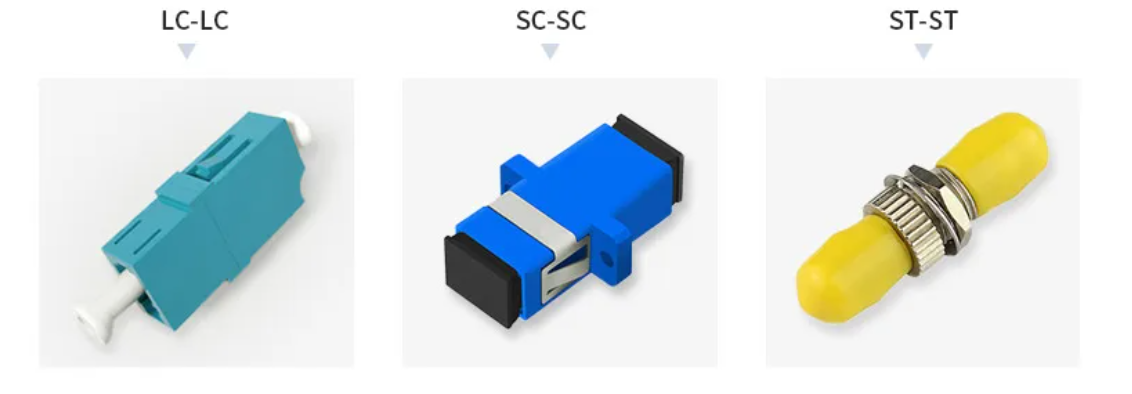FIBER ADAPTERS BUYING GUIDES
What Is Fiber Optic Adapter and How to Choose It
Fiber optic adapters play a crucial role in accurately terminating optical fiber cables or connectors. They find extensive use in various systems such as fiber communication systems, LANs, and FTTH (Fiber to the Home). Given the plethora of fiber optic adapter types available in the market, selecting the appropriate one can be challenging. This blog post aims to elucidate the concept of fiber optic adapters, explore the different types available, and provide guidance on selecting the most suitable adapter for specific requirements.
Fiber Optic Adapter Types
The fundamental characteristic of a fiber optic adapter is the type of connector present at each end. Fiber optic adapters are categorized based on whether the connectors at both ends are identical or different. The types of fiber optic adapters include: Connectors are identical at each end
• LC-LC
• SC-SC
• ST-ST
• FC-FC
• MPO-MPO

Connectors are different at each end:
• LC-SC
• LC-ST
• LC-FC
• SC-ST
• SC-FC
• FC-ST


Additionally, depending on the specific fiber transmission modes and the type of fiber cores accommodated, optic adapters can be categorized into simplex/duplex fiber optic adapters and single mode/multimode fiber optic adapters.
How to Choose Fiber Optic Adapters?
With numerous variations of fiber optic cable adapters available, it's common for them to appear quite similar in physical design, which can lead to confusion when selecting the appropriate one. The following blog will offer several guidelines to aid in the selection process for fiber optic adapters.
1. Before purchasing, determine the type of fiber cable you need to connect. If you're connecting two different fiber cable types, you'll require a hybrid fiber optic adapter.
2. Select appropriate sleeve materials. Alignment sleeves are typically made of metal or ceramic. It has been demonstrated that ceramic-made sleeves outperform metal-made ones due to the superior firmness and stability of ceramic structures. Conversely, metal materials are prone to deformation. Therefore, ceramic-made fiber optic adapters are better suited for ensuring a secure connection.
3. Verify the insertion loss of the fiber optic adapter. Insertion loss refers to the decrease in optical power caused by the adapter. It primarily results from deviation when connecting two optical fibers. When the two fibers are aligned, deviation is minimal, leading to very low insertion loss. However, achieving such ideal insertion loss is often challenging due to various factors affecting fiber connection, including the physical properties of the fiber itself and the precision of the fiber optic adapter's manufacturing process. Hence, selecting a reputable manufacturer is crucial to minimize insertion loss effectively.
Filtering high-quality fiber optic adapters is essential as they may be small but play a significant role in the integrity of the entire fiber link. Therefore, selecting a trustworthy manufacturer is paramount. A dependable fiber optic adapter should offer the following characteristics:
• Minimal insertion loss: Typically, insertion loss should be kept below 0.2dB to maintain optimal performance.
• Excellent repeatability: Given that fiber optic adapters are frequently inserted and removed during operation, they need to withstand repeated use. A standard requirement is for the adapter to endure at least 500 insertion and extraction cycles without compromising performance.
• Ceramic sleeve construction: Ceramics possess a rigid crystal structure that prevents deformation, enabling swift and precise connections. Compared to metal sleeves, ceramic-made adapters offer more dependable performance.
How to Clean a Fiber Optic Adapter?
Like other fiber optic components, fiber optic cable adapters require regular cleaning to prevent contamination that could potentially damage the fiber core and reduce output power. Effective cleaning methods for optical fiber adapters include:
1. Utilizing a fiber optic cleaning box: This box features built-in fiber optic cleaning tape with strong anti-static properties, minimizing the risk of secondary pollution by preventing dust from reattaching to the ferrule after cleaning.
2. Employing a fiber optic cleaner pen: These pens are user-friendly and easy to operate, resembling a common pen in shape. They allow for a full 180° rotation during cleaning, and emit a "Kata" tone to indicate effective cleaning.
3. Using fiber optic cleaning swabs: Insert the lint-free swab into the sleeve of the fiber optic adapter and rotate it to effectively remove contaminants.

Check out AMP’s wide range of fiber adapters with all specifications and product details